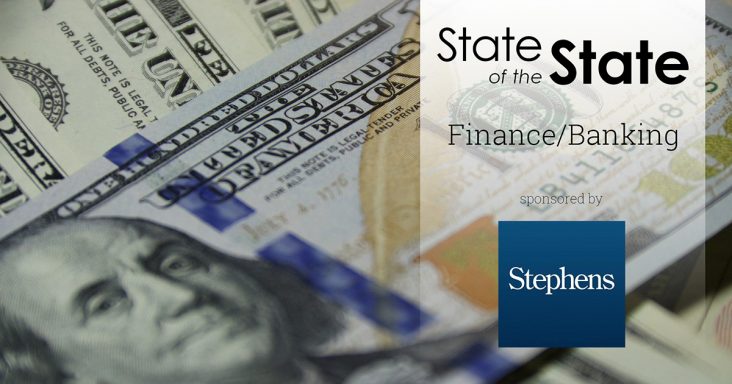Banking to continue focus on technology; vaccines and stimulus needed for consumer rebound
by January 5, 2021 9:41 am 1,084 views

It would not be easy to forecast what might unfold in the state’s banking sector in 2021 without first taking a look back.
“2020 was certainly a challenging environment,” said George Gleason, chairman and CEO of Bank OZK in Little Rock, the state’s largest bank. “I don’t know that I would characterize it as the most challenging [year] in my 41-year career. But it has been a challenging year.”
The COVID-19 pandemic presented severe challenges for banks in 2020. As the health crisis’ economic effects spread, retail banks found themselves coping with some big priorities that required a specific course of action for the present — think Paycheck Protection Program loans — while also rethinking strategies for the future.
“I am optimistic that 2021 will be more routine than 2020,” said Jon Harrell, chairman and CEO of Generations Bank in Rogers, and chairman of the Arkansas Bankers Association. “But the impact of 2020 will continue into next year. Community banks continue to work with customers to get their PPP loans forgiven and there are still significant sectors of our markets like hospitality and retail that we will continue to have to work with until things level out.”

Brad Crain is president and CEO of Arvest Benton County, the largest of the company’s 14 locally managed markets in Arkansas, Kansas, Missouri and Oklahoma. He said that while COVID-19’s impact on the banking sector is not fully understood yet, it will not be as significant as the financial crisis of 2008.

“Much of the outlook for 2021 will depend upon possible future government stimulus and relief and how long it takes for the consumer to rebound fully,” Crain said. “Most importantly, I believe banks will continue to be reliable stabilizers for our communities and customers — both consumer and commercial — and for the economy in general.
“We are here, now more than ever, to provide the products and services our customers need.”
All three banking executives agree that products and services in 2021 will continue to focus on technology improvements. When the pandemic arrived, most banks entered a crisis mode of building or expanding digital capabilities that allowed customers to conduct banking business without stepping foot inside a brick-and-mortar branch. Capitalizing on customer habits newly formed in 2020 will be a focus.
“Technology and the ease of use of bank products will continue to be critical to the future of the industry,” Harrell said. “That will also affect what the future bank branch will look like.”
Gleason said Bank OZK has been committed to building its technology know-how for several years. A group of about 50 software engineers, code writers and application builders known as OZK Labs are based in St. Petersburg, Fla.

“The banks that have meaningful technological products and services are going to thrive, and banks that have average to inferior technology products to serve their customers will be challenged to keep up,” Gleason said. “The customer demands for technology solutions are increasing every day.”
Crain said some industry analysts say the digital channel adoption has been advanced by 5 to 10 years because of the COVID-19 pandemic.
“The digitization of banking has accelerated over the last year, and I expect that to continue,” Crain said. “Customer satisfaction around growing digitization must be a core focus. How banks will build blended service models combining both digital and in-person to enhance customer satisfaction is key.
“Before COVID-19, withdrawing and depositing cash were the top in branch activities. As digital payments become the norm, we expect the branch to become a place for meaningful conversations about customers’ financial well-being. Banks that have invested in robust digital channels will likely experience solid growth and a more stable customer base if they can balance that with high-quality customer experience by being financial advisors to their customers in the branch experience.”
Gleason described a bank’s relationship with customers as symbiotic – what’s good for the customers is good for the bank, and vice versa. He said the top prospect for both in 2021 is the favorable prospect for widespread COVID-19 vaccine distribution.
“That will finally put this COVID-19 pandemic behind us,” he said. “That’s going to be good for our customers and the economy, and that will be good for the banks.”

Harrell said the low interest rate environment would push banks’ net interest margins lower, and that’s a cause for concern. It puts pressure on banks to look for ways to increase non-interest income.
“The boost to the residential real estate market has been one positive of the low interest rate environment,” he said. “Assuming demand remains strong, home sales and refinancing are a good source of non-interest income for banks.”
Working from home will continue to impact many companies, banks included. Harrell said it appears productivity has not suffered, while the potential cost savings due to less overhead will intrigue many organizations. Crain said from an operations standpoint, he expects banks, like other industries, will continue to adjust to employees working remotely and stressing flexible workplace models.
